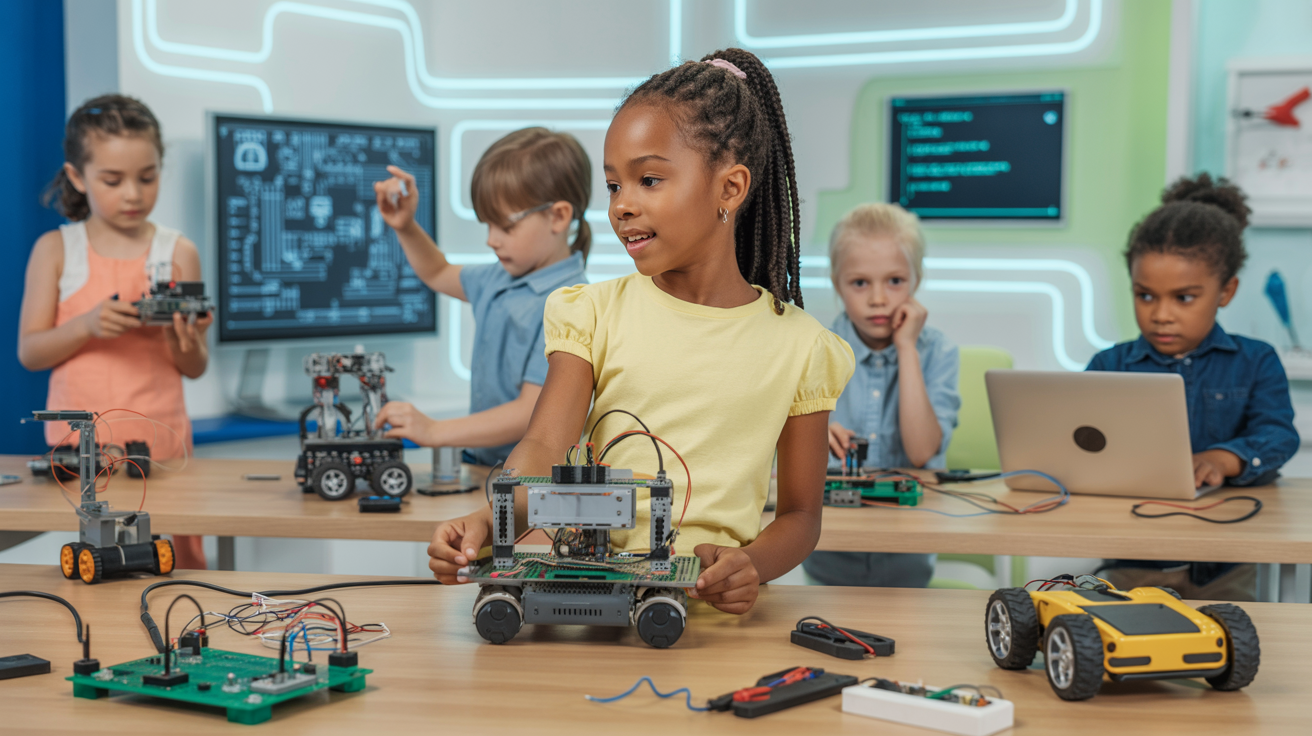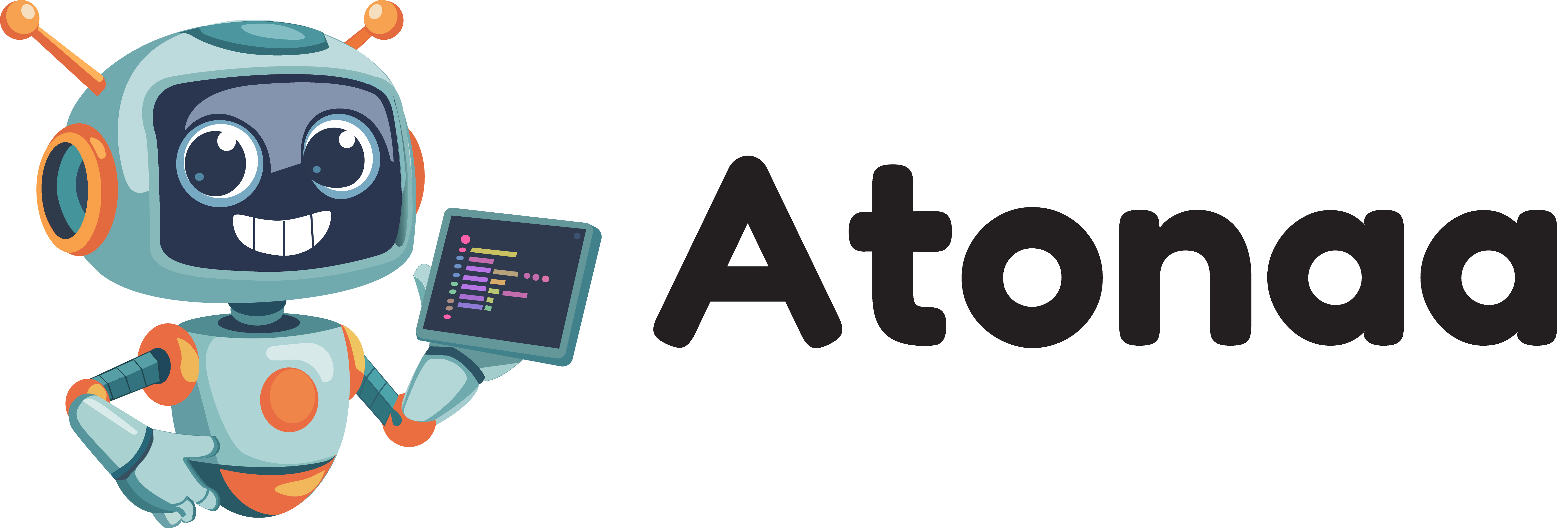Robotics
Robotics

Atonaa Learning Path
The Vanguard Program
The Vanguard Program is Atonaa’s signature long-term learning journey, designed to guide students from curious beginners to confident tech innovators. Spanning nine structured levels across four key age groups — Level 1 (ages 5–7), Levels 2–4 (ages 8–11), Levels 5–6 (ages 12–14), and Levels 7–9 (ages 15–18) — the Vanguard Program builds cumulative, future-ready skills in Web Development, Game Development, Artificial Intelligence, and Digital Media. Each level runs for 10 months (standard) or 6 months (accelerated), with weekly lessons, hands-on projects, collaborative challenges, and showcase opportunities. Students move from block-based platforms like Scratch into professional tools like Python, HTML/CSS, JavaScript, React, Unity, Godot, TensorFlow, and Canva — all while developing design thinking, creativity, entrepreneurial mindsets, and real-world problem-solving skills. The program is intentionally scaffolded to grow with your child — from foundational concepts all the way to full product launches, portfolio development, and industry-level projects by graduation.

Choose Your Learning Style
Group Class
If your child enjoys learning with others, Atonaa’s group classes are a wonderful way to build confidence, communication, and teamwork. In these small, age-based classes, your child will collaborate with peers, share ideas, and work on exciting projects together—just like in the real world. They’ll be guided by a passionate instructor who encourages creativity while helping each learner grow. Group learning sparks motivation and curiosity, and your child will benefit from both expert teaching and the energy of a fun, interactive classroom community.
2-6 Children | Live Online | 55 Minutes Every Week
Accelerated | 2-6 Children | Live Online | 55 Minutes | Two Times / Week
Private 1:1 Class
If you’re looking for a more focused and flexible experience for your child, Atonaa’s private 1:1 classes are designed just for them. With a dedicated instructor, every session is tailored to your child’s pace, interests, and learning goals. Whether they need extra support or want to move faster, we meet them exactly where they are. This one-on-one approach builds confidence, accelerates skill development, and makes space for your child to explore what excites them most—on their own terms, in a nurturing and encouraging environment.
Private 1:1 | Live Online | 50 Minutes Every Week
Accelerated | Private 1:1 | Live Online | 50 Minutes Every Week
Course Info
Atonaa’s Game Development track for ages 5–7 is a carefully crafted introduction to the world of game creation, designed for young learners with little to no prior experience in coding. This course empowers children to move from simply playing games to understanding how they’re built — using intuitive, visual programming tools like Scratch to explore the logic, structure, and storytelling behind interactive digital experiences. Students learn real computational concepts such as sequences, loops, events, and conditions, all presented in a way that’s engaging, age-appropriate, and fun. Along the way, they also develop essential skills like critical thinking, creativity, persistence, and collaboration as they design, build, and present their own games. More than just a technical course, this program helps children begin to see themselves as creators and problem-solvers, laying the groundwork for future innovation, entrepreneurship, and confidence in a digital world.
Course Features
Prerequisites
None
Level One Course Info
Level One course in Atonaa’s Game Development path introduces your child to the foundational principles of game design and visual programming. Using Scratch, a block-based language developed by MIT, your child will begin developing interactive games while learning key computer science concepts such as sequencing, event handling, loops, conditionals, coordinate-based movement, and variable tracking. Through structured challenges and creative exploration, they’ll build logic-driven systems where characters move, react, and interact based on user input. This course also introduces the full game design cycle—ideation, prototyping, testing, debugging, and presenting—helping your child develop not only technical skills but also creativity, resilience, and user-focused thinking. By the end of the course, your child will have completed their first playable game and built a strong foundation in computational logic, systems thinking, and digital confidence.
Learning Objective
By the end of this level, your child will be able to define the core components of a game—such as goals, feedback, rules, interaction, and outcomes—and use Scratch’s block-based programming to control sprite behavior. They will apply control flow logic including sequences, conditionals, and loops, and handle player input using keyboard or mouse events. Your child will also learn to program basic motion, scoring systems, and audio effects, manipulate sprite positions on the XY-plane, and create multi-scene games using event logic. Additionally, they will be able to debug common visual programming errors and confidently present and explain the logic behind their game to peers or parents.
Key Concepts
- Event-driven programming
- Conditional execution (if, if-else)
- Sprite behavior scripting
- Looping (repeat, forever)
- Coordinate-based movement
- User input detection
- State management (score/lives)
- Game UX: visual feedback, pacing, and flow
- Project-based development cycle: design → build → test → share
Level One Capstone
By the end of Level 1, each student designs and publish a fully functional mini-game built entirely in Scratch. Game will include scorekeeping, animated character interactions, multiple levels, or win/loss conditions. Final presentations emphasize code logic explanation, peer feedback, and creative storytelling.
Language and Platform
- Scratch (MIT): Core programming platform
- Scratch Extensions: Sound and sensor interactions
- Game Design Templates: Custom Atonaa design worksheets
- Paper Prototyping & Storyboards: Logic planning and UI/UX sketching
Technology Requirements
- A desktop or laptop computer (macOS, Windows, or Chromebook)
- A desktop or laptop computer (macOS, Windows, or Chromebook)
- Access to the latest version of Google Chrome
- A reliable internet connection
- Mouse or trackpad for navigation (touchscreens not ideal)
- Headphones (recommended for focused gameplay testing and sound feedback)
- No downloads required — Scratch runs fully online
Level Two Course Info
Level Two of Atonaa’s Game Development path builds on the foundational logic your child learned in Level One by guiding them to design more complex, multi-level games with advanced interactivity and structure. Using Scratch, your child will implement features such as broadcast messaging, scene transitions, power-ups, scoring systems, and basic AI behavior like chasing or randomized movement. They’ll learn to manage game states, create user interfaces with menus and instructions, and refine their games through testing and debugging cycles. With a focus on modular thinking, animation, and player experience, this course empowers your child to build polished, playable games that demonstrate deeper logic, creativity, and technical independence—preparing them for more sophisticated programming challenges ahead.
Learning Objective
By the end of this level, your child will be able to design multi-stage games with structured progression, using broadcast messaging and event triggers to manage transitions and interactions. They will implement game states such as win/loss conditions, player health, and respawns, apply custom sprite animations and character switching logic, and introduce basic NPC behavior using movement algorithms. Your child will also build user interfaces with menus and buttons, create and manipulate game variables like coins and power-ups, test and debug complex logic chains, and present polished, playable games with clear objectives and strong replay value.
Key Concepts
- Modular game logic and code reuse
- Scene management via broadcast control
- Game states and conditional flow control
- Custom variables for collectibles, stats, and power-ups
- Sprite cloning and enemy AI simulation
- UX/UI considerations (menus, instructions, HUDs)
- Game loop refinement through feedback and debugging cycles
Level Two Capstone
Each learner will design and develop a multi-level interactive game featuring progression, animated sequences, win/lose outcomes, and a clear narrative or thematic goal. Games will include scoring, power-ups, enemy logic, and UI components. Final presentations will include live gameplay demo, explanation of the game system, and optional peer feedback sessions.
Language and Platform
- Scratch (MIT): Core programming platform
- Scratch Extensions: Sound and sensor interactions
- Game Design Templates: Custom Atonaa design worksheets
- Paper Prototyping & Storyboards: Logic planning and UI/UX sketching
Technology Requirements
- A desktop or laptop computer (macOS, Windows, or Chromebook)
- Access to the latest version of Google Chrome
- A reliable internet connection
- Mouse or trackpad for navigation (touchscreens not ideal)
- Headphones (recommended for focused gameplay testing and sound feedback)
- No downloads required — Scratch runs fully online
Age 5-7 Graduation Requirements
To graduate from Atonaa’s Vanguard Program for ages 5–7, learners must complete Level 1 and 2 with a demonstrated ability to build and present original digital projects, showcasing foundational skills in logic, design, and tool usage relevant to their learning path (e.g., Scratch, HTML, AI tools, or media editors). They must complete a capstone project, contribute at least three documented works to their personal portfolio, and show readiness for more advanced project-based learning. In addition to technical competence, graduates are expected to demonstrate growing independence, creativity, digital fluency, and essential social skills such as collaboration, communication, and respectful peer interaction—ensuring a well-rounded foundation for innovation in the next stage of their journey.
